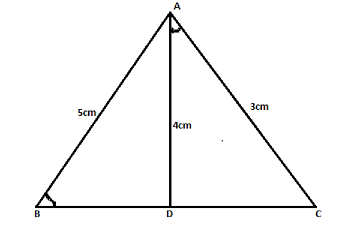
In the adjoining figure D is a point on BC such that, ∠ABD = ∠CAD. If AB = 5cm, AD = 4cm and AC = 3cm. Find A (∆ACD) : A (∆BCA).
Answer
606k+ views
Hint: Visualizing the given data in the question draws an appropriate figure. According to the properties of triangles, observe similarities between the two triangles in order to establish a relation between their angles or sides.

Complete step-by-step answer:
Given data,
∠ABD = ∠CAD. AB = 5cm, AD = 4cm and AC = 3cm.
Let us compare ∆ABC and ∆CAD
∠ABD = ∠CAD (given)
∠ACB = ∠ACD (common angle, from the figure)
The Third Angle theorem states, if two angles of a triangle are congruent to two angles in another triangle, then the third pair of angles are also congruent.
Hence, the third angles of ∆ABC and ∆CAD are congruent
⟹∠CAB = ∠CDA
Using AAA rule, we can say, ∆ABC ~ ∆CAD
(AAA rule, which states if 3 angles are congruent between two triangles then the triangles are similar i.e. of the same shape which typically means the ratio of their areas, ratios of corresponding angles are equal)
Also, the ratio of areas of similar triangles is equal to the ratio of squares of corresponding sides.
⟹ $\dfrac{{{\text{A}}\left( {\Delta {\text{ACD}}} \right)}}{{{\text{A}}\left( {\Delta {\text{BCA}}} \right)}} = {\text{ }}\dfrac{{{\text{A}}{{\text{D}}^2}}}{{{\text{A}}{{\text{B}}^2}}}$
From given AD = 4cm, AB = 5 cm
⟹ $\dfrac{{{\text{A}}\left( {\Delta {\text{ACD}}} \right)}}{{{\text{A}}\left( {\Delta {\text{BCA}}} \right)}} = {\text{ }}\dfrac{{{4^2}}}{{{5^2}}}$
⟹ $\dfrac{{{\text{A}}\left( {\Delta {\text{ACD}}} \right)}}{{{\text{A}}\left( {\Delta {\text{BCA}}} \right)}} = {\text{ }}\dfrac{{16}}{{25}}$
Note: In order to solve these types of questions the key is to make a precise figure which depicts all the given data. Then observe for similarities using properties of triangles. Keep in mind the AAA rule only states that the triangles are similar, they may or may not be congruent.

Complete step-by-step answer:
Given data,
∠ABD = ∠CAD. AB = 5cm, AD = 4cm and AC = 3cm.
Let us compare ∆ABC and ∆CAD
∠ABD = ∠CAD (given)
∠ACB = ∠ACD (common angle, from the figure)
The Third Angle theorem states, if two angles of a triangle are congruent to two angles in another triangle, then the third pair of angles are also congruent.
Hence, the third angles of ∆ABC and ∆CAD are congruent
⟹∠CAB = ∠CDA
Using AAA rule, we can say, ∆ABC ~ ∆CAD
(AAA rule, which states if 3 angles are congruent between two triangles then the triangles are similar i.e. of the same shape which typically means the ratio of their areas, ratios of corresponding angles are equal)
Also, the ratio of areas of similar triangles is equal to the ratio of squares of corresponding sides.
⟹ $\dfrac{{{\text{A}}\left( {\Delta {\text{ACD}}} \right)}}{{{\text{A}}\left( {\Delta {\text{BCA}}} \right)}} = {\text{ }}\dfrac{{{\text{A}}{{\text{D}}^2}}}{{{\text{A}}{{\text{B}}^2}}}$
From given AD = 4cm, AB = 5 cm
⟹ $\dfrac{{{\text{A}}\left( {\Delta {\text{ACD}}} \right)}}{{{\text{A}}\left( {\Delta {\text{BCA}}} \right)}} = {\text{ }}\dfrac{{{4^2}}}{{{5^2}}}$
⟹ $\dfrac{{{\text{A}}\left( {\Delta {\text{ACD}}} \right)}}{{{\text{A}}\left( {\Delta {\text{BCA}}} \right)}} = {\text{ }}\dfrac{{16}}{{25}}$
Note: In order to solve these types of questions the key is to make a precise figure which depicts all the given data. Then observe for similarities using properties of triangles. Keep in mind the AAA rule only states that the triangles are similar, they may or may not be congruent.
Recently Updated Pages
Two men on either side of the cliff 90m height observe class 10 maths CBSE

What happens to glucose which enters nephron along class 10 biology CBSE

Cutting of the Chinese melon means A The business and class 10 social science CBSE

Write a dialogue with at least ten utterances between class 10 english CBSE

Show an aquatic food chain using the following organisms class 10 biology CBSE

A circle is inscribed in an equilateral triangle and class 10 maths CBSE

Trending doubts
Why is there a time difference of about 5 hours between class 10 social science CBSE

Write a letter to the principal requesting him to grant class 10 english CBSE

What is the median of the first 10 natural numbers class 10 maths CBSE

The Equation xxx + 2 is Satisfied when x is Equal to Class 10 Maths

Which of the following does not have a fundamental class 10 physics CBSE

State and prove converse of BPT Basic Proportionality class 10 maths CBSE




